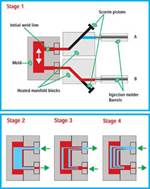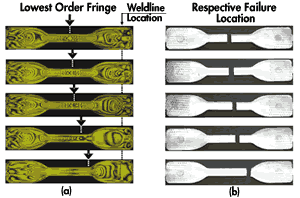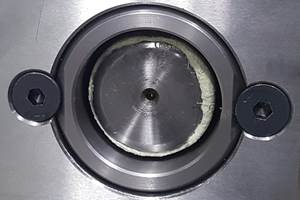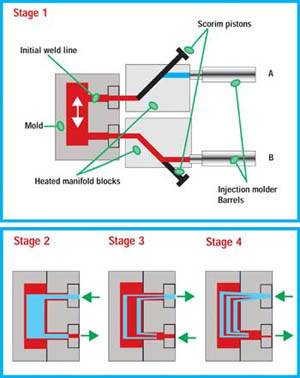Melt-Oscillation Molding Enhances Part Properties
Research into a new melt-oscillation approach for injection molding has yielded a means of enhancing mechanical properties without use of fillers or additives.
Research into a new melt-oscillation approach for injection molding has yielded a means of enhancing mechanical properties without use of fillers or additives. The technique also can move, hide, or reduce weld lines and correct orientation defects.
A team of professors, research associates, and students at the P.C. Rossin College of Engineering and Applied Science at Lehigh University in Bethlehem, Pa., developed a new Vibration Assisted Injection Molding (VAIM) process that uses low-frequency oscillation of the injection screw. Axial motion of the screw oscillates the injection pressure, which better aligns the molecules to improve part strength, explains Prof. John P. Coulter, associate dean and leader of the research team. “By manipulating the melt through changes in flow, shear, molecular alignment, and thermal conditions, we’ve managed to enhance the end product or develop a processing advantage.” Working with the VAIM process on a 15-ton press from Boy Machines, Lehigh has improved tensile properties of a test part by 60%.
The Lehigh VAIM program was presented in a paper at the SPE ANTEC meeting last year in Charlotte, N.C., where it received the Best Injection Molding Research Paper award.
Melt manipulation evolves
Variations on the idea of melt manipulation have been explored in a number of different ways, but the overall idea is similar: After melt is injected into a cavity, while only the melt next to the cavity walls has yet solidified into a skin, pressure external to the mold cavity is used to manipulate the hot melt that remains in the center of the part.
The most widely publicized, but still not widely used, process of this type is called SCORIM, short for Shear Controlled Orientation in Injection Molding. It was developed at Brunel University in Uxbridge, U.K., in 1982. Scorim technology is now owned and offered for license by Cinpres Gas Injection. There are fewer than 10 licensees worldwide.
SCORIM splits the melt into two streams that enter the mold from separate gates. Two hydraulic pistons in the manifold behind each gate are synchronized to alternately push and pull the melt in and out of each gate, moving the melt back and forth within the tool. The two pistons can be moved forward together for additional compression before the part freezes completely. This process can move the weld line to any desired position and also ensures maximum and uniform packing.
A variation on the SCORIM process produces parts using dissimilar materials. The Multi-Component Laminate Molding (MLM) process was developed in 2002 at the Wolfson Centre for Materials Processing at Brunel University. Here, each piston in the mold manifold delivers a separate stream of resin through a common manifold block to the tool. Melt pushed by one piston displaces warm melt in the center of the part, pushing it back into the decompressing piston. Part of that melt cools and forms a frozen layer, but the remaining melt in the center is then displaced by material from the opposing piston. This results in a layered material structure in the part.
Among other melt-oscillation processes, Klockner Ferromatik Desma in Germany (now Ferromatik Milacron Europe) introduced “push-pull” molding at the K ’89 show in Dusseldorf. And a company called Solomat Partners, formerly located in Stamford, Conn., introduced a similar process called Rheomolding in 1994 (See Learn More box).
Screw control is key
The VAIM technique being studied at Lehigh differs from SCORIM in that it requires no special mold design, nor any physical changes to the molding press. Like SCORIM or MLM, the tool has at least two gates. Lehigh installed pressure transducers on the screw and at the end of the cavity to measure the injection pressure. Lehigh also developed its own cold-runner valve technology that helps to adjust the fill and packing stages.
To implement VAIM, Lehigh developed PC software to control a hydraulic valve on the Boy press that governs positioning and movement of the injection screw. The control program causes the injection screw to move back and forth in the injection chamber at low frequency (4 to 8 Hz) to compress and decompress the melt. The screw oscillation changes the melt pressure no more than 15%. The peak injection pressure is no higher than would normally be used, says Coulter, and the oscillation drops about 15% below that.
The controller can oscillate the screw up to 15 times in a cycle, but depending on the material and other factors, it is sometimes only four or five times.
Lehigh can adjust its VAIM process to move the part’s weld line to any desired position. Melt manipulation can also position the weakest point associated with molecular orientation in a more favorable place. Coulter explains that the weakest point in a part isn’t necessarily the weld line. “The weak point is where the least desirable molecular orientation is. You often get low molecular orientation in regions far from a gate and high orientation close to the gate. Since there are differences in orientation, there will be a weak spot, irrespective of weld lines,” says Coulter.
Encouraging results
In one VAIM trial, the Lehigh researchers enhanced the tensile strength of different grades of polystyrene. VAIM produced parts made of a 50/50 blend of recycled and virgin PS that were stronger than 100% virgin processed conventionally. “The ability to use regrind and improve specific properties represents a financial opportunity for processors competing in a global economy,” says Coulter.
Parts produced by VAIM also show improved mechanical properties in the transverse as well as the main flow direction. “It was assumed that if you oriented the polymer molecules in direction ‘A’ you hurt properties in direction ‘B.’ But recent work has shown an increase in strength in both directions,” Coulter says.
“We couldn’t be more excited by this innovative program and the way our machine is being used in it,” says Robert Koch, president of Boy Machines. “We hope to work together from here to help Boy customers utilize melt manipulation to gain performance advantages.”
Related Content
Hot Runners: A View from the Bottom Up
Addressing hot-runner benefits, improvements, and everyday issues from the perspective of decades of experience with probably every brand on the market. Part 1 of 2.
Read MoreHow to Select the Right Tool Steel for Mold Cavities
With cavity steel or alloy selection there are many variables that can dictate the best option.
Read MoreWhat You Need to Know About Leader Pins and Bushings
There’s a lot more to these humble but essential mold components than you might suspect. Following the author’s tips could save much time, money and frustration.
Read MoreImprove The Cooling Performance Of Your Molds
Need to figure out your mold-cooling energy requirements for the various polymers you run? What about sizing cooling circuits so they provide adequate cooling capacity? Learn the tricks of the trade here.
Read MoreRead Next
Two New Ideas for Injection Molding Unveiled at ANTEC Meeting
A new method of coinjection molding dissimilar materials was presented at this year's SPE Annual Technical Conference in San Francisco.
Read MoreHow Polymer Melts in Single-Screw Extruders
Understanding how polymer melts in a single-screw extruder could help you optimize your screw design to eliminate defect-causing solid polymer fragments.
Read More

























